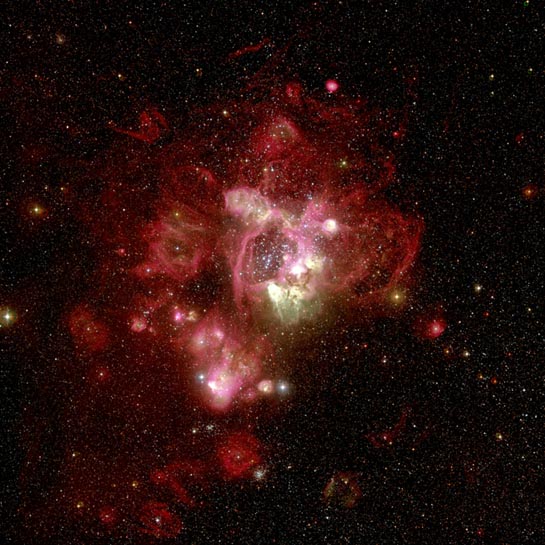
Description: H II Region Emission Nebula
Position (J2000): RA 5hr 21m 36.19s Dec -67° 54' 43.15"
Constellation: Dorado
Distance: 170,000 light years
Field of view: 32.28 x 32.38 arcminutes
Orientation: North is 0.0° right of vertical
Image Credit: ESO
Release date: November 3, 2003
Central region: N0332b NGC 1929: S1208cx
ABOUT THIS IMAGE:
The two best known satellite galaxies of the Milky Way, the Magellanic Clouds, are located in the southern sky at a distance of about 170,000 light-years. They host many giant nebular complexes with very hot and luminous stars whose intense ultraviolet radiation causes the surrounding interstellar gas to glow. Pictured here is the southern part of the spectacular N44 H II region in the from the Wide-Field-Imager (WFI) at the ESO/MPG 2.2-m telescope. The green color indicates areas that are particularly hot.
The intricate and colorful nebulae are produced by ionized gas [1] that shines as electrons and positively charged atomic nuclei recombine, emitting a cascade of photons at well defined wavelengths. Such nebulae are called "H II regions", signifying ionized hydrogen, i.e. hydrogen atoms that have lost one electron (protons). Their spectra are characterized by emission lines whose relative intensities carry useful information about the composition of the emitting gas, its temperature, as well as the mechanisms that cause the ionization. Since the wavelengths of these spectral lines correspond to different colors, these alone are already very informative about the physical conditions of the gas.
N44 [2] in the Large Magellanic Cloud is a spectacular example of such a giant H II region. Having observed it in 1999, a team of European astronomers again used the Wide-Field-Imager (WFI) at the MPG/ESO 2.2-m telescope of the La Silla Observatory, pointing this 67-million pixel digital camera to the same sky region in order to provide another striking - and scientifically extremely rich - image of this complex of nebulae. With a size of roughly 1,000 light-years, the peculiar shape of N44 clearly outlines a ring that includes a bright stellar association of about 40 very luminous and bluish stars.
These stars are the origin of powerful "stellar winds" that blow away the surrounding gas, piling it up and creating gigantic interstellar bubbles. Such massive stars end their lives as exploding supernovae that expel their outer layers at high speeds, typically about 10,000 km/sec.
It
is quite likely that some supernovae have already exploded in N44 during
the past few million years, thereby "sweeping" away the surrounding
gas. Smaller bubbles, filaments, bright knots, and other structures in
the gas together testify to the extremely complex structures in this region,
kept in continuous motion by the fast outflows from the most massive stars
in the area.
The colors reproduced in the new WFI image of N44, shown in this ESO Press Photo (with smaller fields in more detail in ESO Press Photos n0332b) sample three strong spectral emission lines. The blue color is mainly contributed by emission from singly-ionized oxygen atoms (shining at the ultraviolet wavelength 372.7 nm), while the green color comes from doubly-ionized oxygen atoms (wavelength 500.7 nm). The red color is due to the H-alpha line of hydrogen (wavelength 656.2 nm), emitted when protons and electrons combine to form hydrogen atoms. The red color therefore traces the extremely complex distribution of ionized hydrogen within the nebulae while the difference between the blue and the green color indicates regions of different temperatures: the hotter the gas, the more doubly-ionized oxygen it contains and, hence, the greener the color is.
The composite photo produced in this way approximates the real colors of the nebula. Most of the region appears with a pinkish color (a mixture of blue and red) since, under the normal temperature conditions that characterize most of this H II region, the red light emitted in the H-alpha line and the blue light emitted in the line of singly-ionized oxygen are more intense than that emitted in the line of the doubly-ionized oxygen (green).
However,
some regions stand out because of their distinctly greener shade and their
high brightness. Each of these regions contains at least one extremely
hot star with a temperature somewhere between 30,000 and 70,000 degrees.
Its intense ultraviolet radiation heats the surrounding gas to a higher
temperature, whereby more oxygen atoms are doubly ionized and the emission
of green light is correspondingly stronger.
By contrast, this image was a three-color composite produced by means of two broad-band filter exposures in blue and green light and one H-alpha exposure, and therefore outlining the general appearance of the ionized region. Says Fernando Comerón, leader of the team: "Thanks to the use of a UV-filter and two narrow-band filters isolating the emission of specific ions, the new picture provides much more information about the complicated physics of the excited interstellar gas in the region."
Nausicaa
Delmotte, member of the team, adds: "With its colorful beauty, N44
is a display of the violent phenomena that occur as the heaviest known
stars unfold their power on the parental gas out of which they were born."
Notes:
[1]: A gas is said to be ionized when its atoms have lost one or more electrons - in this case by the action of energetic ultraviolet radiation emitted by very hot and luminous stars close by.
[2]:
The letter "N" (for "Nebula") in the designation of
these objects indicates that they were included in the "Catalogue
of H-alpha emission stars and nebulae in the Magellanic Clouds" compiled
and published in 1956 by American astronomer-astronaut Karl Henize (1926
- 1993).